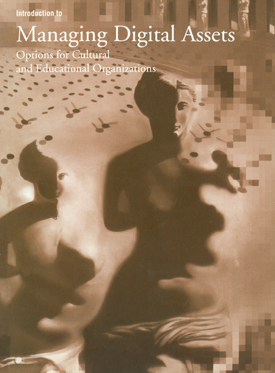
Introduction to Managing Digital Assets: Options for Cultural and Educational Organizations
Diane M. Zorich, Eleanor E. Fink
1999
168 pages
PDF file size: 73.9 MB
Description
As the use of electronic networks becomes more ubiquitous in the cultural and educational community, issues of management, communication, and distribution increase in complexity. Within this digital environment, options and strategies regarding an institutions intellectual and cultural property take on critical importance.
Introduction to Managing Digital Assets reviews the traditions of rights administration and content distribution in various creative sectors, and identifies common structures and functions within these organizations. The book explores the relationships among the provider, the rightsholder, and the user, highlighting issues of particular relevance to cultural and educational communities.
The Introduction To series acquaints professionals and students with the complex issues and technologies in the production, management, and dissemination of cultural heritage information resources.
Table of Contents
-
Foreword
Eleanor E. Fink - Acknowledgments
- Executive Summary
-
1. Introduction
- A. Project History and Genesis
- B. Goals and Assumptions
-
2. What Are Intellectual Property Rights?
- A. Intellectual Property Rights in the United States
- B. A Brief History of Copyright
- C. The Nature of Rights in Copyright
- D. The Complexity of Rights in an Electronic Environment
-
E. Current Rights Management Methods
- Direct Administration
- Collective Administration
- F. The Emergence and Perseverance of Rights Management
-
3. The Distribution of Intellectual Property over Electronic Networks
-
A. Access Issues
- Ease of Reproduction
- Reproduction as a Prerequisite to Use
- Worldwide Distribution Channels
- Transformative Effect
-
B. Special Issues for Cultural and Educational Institutions
- The State of Intellectual Property in Cultural Organizations
- Determining Value
- Fair Use and the Digital Environment
- Other Uncertainties: Licensing, Assurances, Economics, and Markets
-
A. Access Issues
- A. Current State of Affairs: Direct Administration
-
B. Changes on the Horizon: Options for the Cultural Heritage Community
- Continuing with Direct Administration
- In-house Expansion and Restructuring
- Outsourcing with an External Agency
- Joining a Rightsholders’ Collective, Cooperative, or Consortium
-
A. Formation and Development
- History and Startup Relationships
- Size and Scale
- Organizational Mission
- Governance Structures
-
B. Methods of Operation
- Management Traditions by Genre
- Models of Operation
- Basic Services
- Other Operational Issues
-
6. Managing Content and Usage
-
A. Content
- Selection
- Quality and Quantity
- Contextual Information
- Location and Distribution
-
B. Usage
- Electronic Environments
- Permissible Uses
- Restrictions
- Fair Use
-
A. Content
-
A. Rightsholder Issues
- Rightsholder Incentives
- Assigning Rights
- Terms of Agreement
- Reporting
- Administrative Burdens
-
B. User Issues
- User Incentives
- User Participation
- User Fees and Costs
- Administrative Burdens
- A. Revenue Sources
- B. Assessing Economic Value
- C. Determining Costs
-
D. Pricing
- Who Sets Fees?
- Fee Structures
- Licenses
- E. Collecting Fees
- F. Redistributing Revenues
- A. Issues
- B. Newly Emerging Trends
-
C. Continuing Challenges
- Copyright
- Management in Electronic Environments
- D. The Next Steps
- A. Introduction
-
B. Options for Administration of Intellectual Property Rights in Canadian Cultural Heritage Institutions
- Collective Administration in Canada: A Legal Framework
- Collective Administration of Performing Rights
- Collective Administration of Retransmission Rights
- Other Collective Societies
- Other Legal Factors Affecting Collective Administration
- Theory and Practice: The Operating Environment
- Quebecs Unique Environment
- The Relationship between the Author and the Collective
- The Relationship between the Collective and the User
- Potential for the FutureLicensing Electronic Rights
- Conclusion
- A. A Note on Methodology
- B. Organizations and Projects Reviewed
- C. Review Questions
- D. Questionnaire for Reviewing Intellectual Property Management Service Providers
About the Authors
Diane M. Zorich is an information management consultant specializing in cultural information on electronic networks.